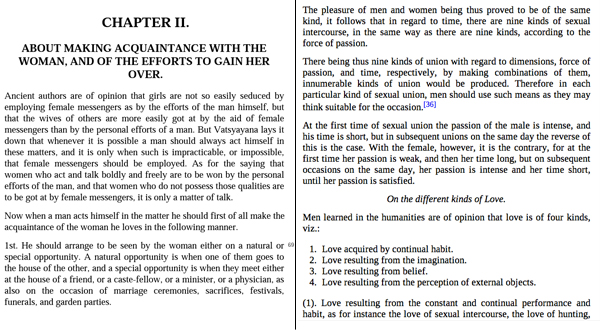According to John Sutherland, Marshall McLuhan used to browse page 69 to decide whether to buy a book or not. However he would have some problems applying this technique in the digital era. As a matter of fact in the open and free ePub format, which is becoming the standard for ebooks, the number of pages is not fixed, but rather it changes according to the reading platform.

fig. 1 The Kama Sutra of Vatsyayana epub version, p. 69/130 on Adobe Digital Editions.
fig. 2 The Kama Sutra of Vatsyayana epub version, p. 69/346 on Calibre.
Currently there are several criteria in use to divide the book’s content in pages, for instance Adobe Digital Editions describe its system in this way:
Determine a compressed byte length of each resource which is referenced in the spine, subtracting any known encryption overhead (IV size)
Assume that there is a page for each 1024 bytes…
So what we call “page” becomes a determined quantity of data. This means that a picture, which is commonly heavier than plain text, will occupy more pages. On the other hand Sony BBeB reader counts “pages” in units of “screenfuls of text.” In this case page numbers will change according to the font size. In the debate on how should pages be visualized there is also a proposal which concerns the adoption of incremental percentage (Eg. You’re at the 80% of the book.) Actually there are some attempts to embed the same printed version’s page numbers but they’re still in the early stages.
This chaotic situation is not only a problem for non-orthodox practices like McLuhan’s one. We should consider it as another confirmation that ebooks are different from p-books. Many people argue that the pagination system make no sense for ebooks, because there are no actual pages. With the current systems we have different page numbers for the same ebook and we can’t understand precisely the book’s length and our position in it. Bigger problems come up in the field of academic studies. How to quote a sentence in a page? How to compare different editions of the same book? And so on…
A consistent number pages’ system that goes through printed and digital versioning is necessary in order to take reap from both platforms. Hybrid solutions are already common as they allow the user to read in a linear and concentrated way on printed paper and, at the same time, to browse the digital version of the book in a non-linear way (word search for example). In this perspective ebooks and printed books don’t represent a dichotomy but rather, they can be considered complementary.


